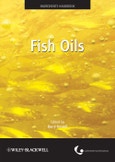The fourth in a series of Handbooks edited by Dr Barry Rossell, the book is a very useful source of information for all those working in the food industry with any involvement in the use of, or research into, fish oils.
The book includes information on:
- The important dietary constituents in fish oils
- Physical properties such as flash point, density, viscosity, optical properties and Thermal conductivity
- Fatty acids in fish oils
- Processing methodology
- The nutritional benefits of fish oils
- Uses of liquid fish oils in foods
- Rancidity in fish oils and its prevention
- Legislation covering fish oil production and use
Table of Contents
Contributors vi
Introduction ix
1 Production Volumes and Trade in Fish Oils 1
2 Fish Oils as Sources of Valuable Dietary Constituents 7
2.1 Introduction 7
2.2 Squalene 7
2.3 Vitamins 8
2.4 Glycerol ethers 8
2.5 Long-chain polyunsaturated fatty acids 8
2.6 References 11
3 Physical Properties of Fish Oils 13
3.1 Introduction 13
3.2 Mechanical Properties 15
3.3 Electrical and Dielectric Properties 18
3.4 Optical Properties 19
3.5 Smoke, Flash and Fire Points 21
3.6 Heats of Combustion 22
3.7 Thermal Properties 23
3.8 Spectral Properties of Fish Oils 30
3.9 Other Physical Properties 33
3.10 Physical Properties of Fish Wax Esters 34
3.11 Conclusions 34
3.12 References 39
4 Fish Oils - The Chemical Building Blocks 51
4.1 Introduction 51
4.2 The Lipid Family 52
4.3 The Origin of Building Blocks 53
4.4 Progression through the Marine Food Web 54
4.5 The Wide Ranging Fatty Acids in Fish Oils 55
4.6 The Esterified Materials 64
4.7 Other Chemical Constituents in Fish Oils 70
4.8 Conclusions 75
4.9 References 75
5 Processing of Fish Oil 81
5.1 Introduction 81
5.2 Minor Components in Crude Fish Oils 84
5.3 Processes Used 87
5.4 Refining Crude Fish Oil for Nutraceuticals 95
5.5 References 97
5.6 Glossary of Terms Used 98
6 Hydrogenation of Fish Oils 99
6.1 Summary 99
6.2 Batch Hydrogenation 99
6.3 Principles of Hydrogenation Technology 102
6.4 Principles of Dead-end Batch Reactor Operation 111
6.5 Application to Large-scale Reactors 118
6.6 Hydrogenation Time 122
6.7 Final Remarks 126
6.8 Acknowledgements 126
6.9 List of Symbols 127
6.10 References 129
7 Nutritional Values of Fish Oils 131
7.1 Introduction 131
7.2 History 132
7.3 Vitamins 133
7.4 Fatty Acids 137
7.5 The Uniqueness of Fish Oils 140
7.6 The Biological Role of Poylunsaturates 141
7.7 Dietary Alterations 142
7.8 Clinical Aspects 143
7.9 Summary 151
7.10 References 152
8 Uses in Foods of Non-Hydrogenated Fish Oils 155
8.1 Introduction 155
8.2 Supplements or Fortification of Foods? 156
8.3 Fish Oils and their Various Forms 159
8.4 Methods Used to Raise Omega-3 Concentration 160
8.5 The Products Available Currently 163
8.6 Microencapsulation 166
8.7 Algal Oils 167
8.8 Future Prospects 167
9 Farmed Fish: The Impact of Diet on Fatty Acid Compositions 171
9.1 Introduction 171
9.2 Aquaculture Feeds; a Work in Progress 172
9.3 Dietary Lipid and Flesh Fatty Acid Concentration in Farmed and Wild Fish 173
9.4 Flesh n-3 Highly Unsaturated Fatty Acid (HUFA) Concentrations in Farmed and Wild Fish 174
9.5 Fatty Acid Compositions of Liver Oils from Farmed and Wild Fish 176
9.6 Conclusion and Future Prospects 178
9.7 References 179
10 Rancidity in Fish Oil 185
10.1 Introduction 185
10.2 Fish Oil Processing 185
10.3 Fish Types 186
10.4 Fish Oil Storage and Transport 187
10.5 Polymerisation 189
10.6 Absorption/Contamination 190
10.7 Hydrolisis 191
10.8 Induction Period 193
10.9 Oxidation 195
10.10 Autoxidation 197
10.11 Antioxidants 200
10.12 Photo-oxidation 203
10.13 Applications of Antioxidants 205
10.14 Conclusions 221
10.15 References 222
11 Regulatory Issues for Fish Oils 225
11.1 Introduction 225
11.2 Composition 226
11.3 Use in Food Supplements 227
11.4 Novel Foods 229
11.5 Labelling Issues for Fish Oils in Foods 230
11.6 Hygiene Requirements 234
11.7 Contaminants 236
11.8 Additives 237
11.9 References 240
Index 243








